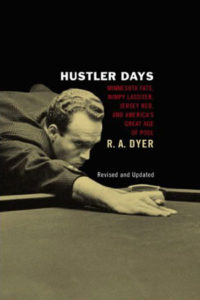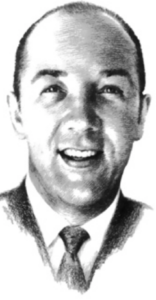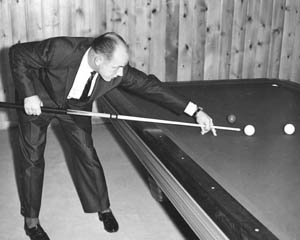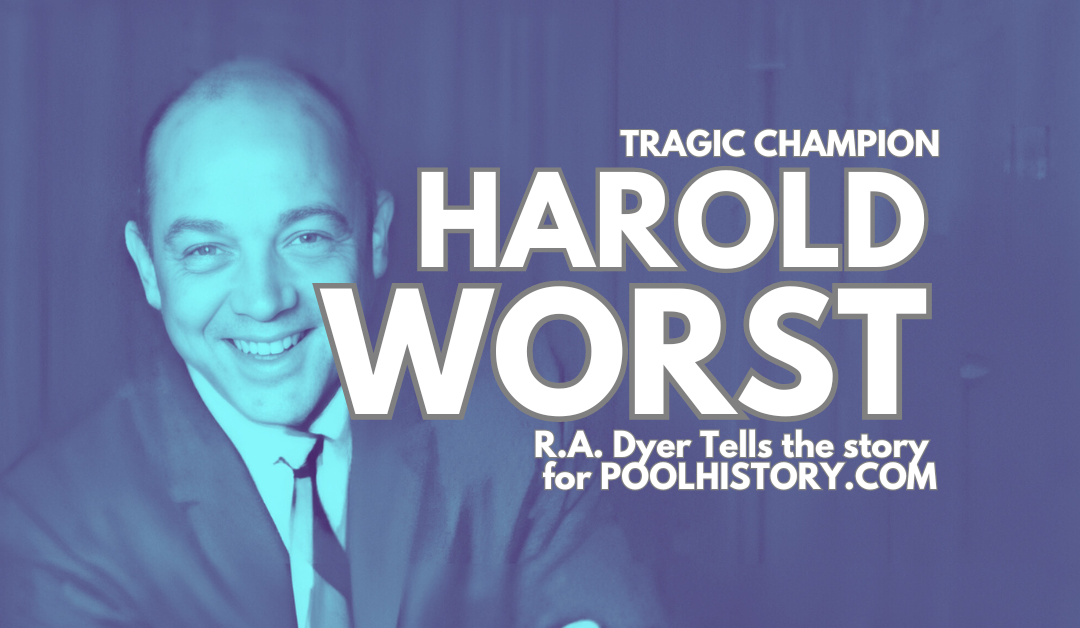Harold Worst was one of very few champions to have successfully made the leap from three-cushion to pocket billiards.
________________________________________________
By R.A. Dyer
In 1954, on a Monday night, the then-dictator of Argentina sat down to a fine dinner. At his table was a young American billiard star, a second American, the dictator’s beautiful wife, and perhaps a few hangers-on. The meal was said to have been sumptuous, the cocktails never-ending, the populist strongman gracious if not exactly ebullient. And this dictator, then the most powerful man in Argentina – indeed, one of the most powerful men then living in Latin America – had a bit of free advice for the young American billiard star.
“Leave the country,” Juan Peron reportedly said. “Vayanse manana. Go tomorrow. Don’t wait.”
The billiard star did not need to be told twice. The very next morning he gathered up his belongings and caught the first flight to New York. There would be no souvenir shopping. He did not visit the countryside. But neither did the American leave empty-handed because in his pocket were two wondrous new acquisitions: a fat paycheck and the world’s three-cushion billiard title. The money would quickly be gone, but Harold Worst, then just 25 years old, would keep the billiard title for as long as he drew breath.

Some of this content appeared earlier in the revised edition of Hustler Days.
What follows is my description of the early life of Harold Worst, as originally told in the Untold Stories column in Billiards Digest and reprinted in my first book, Hustler Days. Worst had everything: he beat all comers in three-cushion billiards; he was a top notch one-pocket pocket player; he killed at straight pool. He was, in fact, one of very few champions to have successfully made the leap from three-cushion to pocket billiards. Sadly, however, he died early, struck down by cancer near his prime on June 16, 1966.
GRAND RAPIDS, MICHIGAN
Worst was born on Sept. 29, 1929, in Grand Rapids, Mich. He was the son of Harry J. and Lavina Worst, both devout Reform Christians. His father did not play pool competitively, although the Worsts had pool and ping-pong tables in the basement of their Grand Rapids home. Young Harold (also known as Hal or even “Boola,” a nickname given to him by a childhood chum) attended Grand Rapids Creston High School, was a regular at Alger Park Christian Reform Church, and enjoyed the eating of T-bone steaks. He held two jobs early in life: He sold advertising space for the local newspaper, and shoes for his dad.
At about age 17, while at Big White Fish Lake with his family, Worst made the acquaintance of Tena Huisman. Both the Worst and Huisman families owned summer cottages at the lake, and when young Harold wasn’t fishing for pike, perch and blue gill, he would gather with Tena and other youngsters at a big pavilion in the middle of town. Tena and Harold would also stroll arm-in-arm at the carnivals held every summer in nearby Sand Lake or go to the movies in Cedar Springs. Tena, who then would have been about 15, recalls that she and Harold began as platonic friends. But they would see each other at the lake every summer (especially during the weekends), and Harold was such an odd duck that before long, she couldn’t help but go steady with him.
For one thing, Harold insisted on wearing a suit.
“He came to the door and he was all dressed up, and I was a young girl, and it just didn’t look normal to me,” Tena recalled during an interview in 2004. “I thought he looked older. And then, as we talked and everything, I could see that he was a lot of fun. He had a terrific laugh on him.”
Just as Harold was taking up with Tena, he was also embarking on the serious study of straight pool and rotation. These studies he began on his table at home, although in no time young Harold had switched to a room just across the street from his father’s East End Shoe Store, and then later he became a regular at the Peninsular Club, also in Grand Rapids.
Eventually Harold graduated to the locally famous Chinnick’s, a poolroom that was really much more than a poolroom. With its restaurant on the first floor, pool tables on the second and bowling on the third, Chinnick’s became a favorite haunt of world-class sports stars and visiting celebrities. There, Worst likely rubbed elbows with heavyweight boxing champions Jack Dempsey and Gene Turney. Middleweight champ Mickey Walker also frequented Chinnick’s.
Worst’s first billiards tutor was Walter Brundage, who died in 1950 at age 81. He also learned from oilman Joe “Red” McDevitt, a respected amateur champ who came to Grand Rapids from Ohio in 1946. McDivitt spent several days each week teaching the young prodigy angles and shots.
By then, Worst would have stood about 6’1″ and weighed 180 pounds. His hair was brown, his eyes hazel. He smiled easily, was friendly (although he never suffered fools), and was a quick learner. So quick, in fact, that Harold Worst soon outstripped McDevitt, his teacher.
“Joe taught me the fundamentals,” Worst said in a February 1950 newspaper article. “Billiards requires concentration more than anything else. Certainly a good pair of eyes and fairly strong wrists are important, but it’s the concentration on the problem that counts. … He (Joe) started me off right, and in billiards it must be that way if you’re going anyplace.”
FRIEND OF WILLIE HOPPE

Harold Worst was inducted into the BCA Hall of Fame in 1970.
If it was from a respected amateur that Harold learned the fundamentals, then it was from the nation’s finest-ever billiards pro that he received his graduate training. Willie Hoppe, considered by many as the finest cueist this nation has ever produced, befriended Worst in 1949. This happened by way of Roy Deak “The Deacon” Nichols, who managed Chinnick’s poolroom, and who was known for spotting and cultivating top-notch talent. The Deacon kept his eye on the smooth-stroking Worst, watching him for long months as he progressed from short-stop to journeyman to potential champion.
According to The Grand Rapids Press, The Deacon contacted Brunswick-Balke, which then sponsored Hoppe and other pool and billiard stars in exhibition tours. As a result of The Deacon’s intercession and a last-minute cancellation of another player, Brunswick-Balke agreed to pit Worst against Hoppe in a Detroit exhibition. Although Worst got beat (by just one point), the event nonetheless cemented his reputation as a world-class contender. The event also became the glue that sealed his lifelong friendship with Hoppe.
In 1949, according to The Grand Rapids Press, “Worst had followed in Hoppe’s steps as a ‘boy wonder,’ having set a record for youth when at the age of 21 he became the youngest player in history to qualify for world championship play.” He placed second in that year’s national tournament and then fourth in the world meet
MARRIAGE AND KOREA
Then came 1950 – November – when Worst’s fortunes shifted in two particularly dramatic ways. First off, he got married. Secondly, he got drafted. Those two life-events were not strictly unrelated, in that Tena agreed to marry Harold knowing that he would face possibly life-threatening dangers in Korea. Harold shipped out with the army’s 244th Ordnance depot company, served basic training in Indianapolis, and then got briefly stationed at Camp Atterbury, Ind.
 He managed to snag a quick furlough to play in that year’s national tournament, where he placed second (with a 7-2 record) after Mexico’s Joe Chamaco. Hoppe, forever in Harold’s corner, predicted afterwards that the new boy wonder would emerge as “the next world champion, providing he can practice as much with a cue as he can with a rifle.” Worst then spent nine months in Korea as a member of the Army graves registration unit – an assignment that forever depressed him.
He managed to snag a quick furlough to play in that year’s national tournament, where he placed second (with a 7-2 record) after Mexico’s Joe Chamaco. Hoppe, forever in Harold’s corner, predicted afterwards that the new boy wonder would emerge as “the next world champion, providing he can practice as much with a cue as he can with a rifle.” Worst then spent nine months in Korea as a member of the Army graves registration unit – an assignment that forever depressed him.
“He had to identify the bodies, and sometimes the whole body wasn’t there, or he would have to find the leg, or an arm, or whatever, before they could ship the body home,” said Tena Worst. “He had to put them in bags and identify them. It’s no wonder that half those men go crazy. You had to have a lot of a faith, and his faith helped him in that. It’s not a pleasant thing.”
Mercifully, Worst later won a transfer to a special services unit, in which he was called upon to give pool lessons and perform exhibitions at military recreation centers. He got discharged in November 1952, and returned to world competition five months later.
San Francisco’s Ray Kilgore won the 1953 world billiards championship, held that April in Chicago. It would be the last such world championship in Harold’s life in which Worst himself did not end up on top. Stripped across the front page of the Oct. 26, 1954, edition of The Grand Rapids Press reads this headline: “Worst Brings City Second World Title.” (The first was from bowler Marion Ladewig.) Accompanying the story is a two-column photograph of Harold attempting a difficult massé shot. He looks dapper in a suit jacket and polka-dot tie.
THE BUENOS AIRES CHAMPIONSHIP
The story tells of Worst’s journey to Buenos Aires, his overall 8-2 record in the tournament, his victory over reigning champion Kilgore (the score was 60-45), and his victory on Oct. 25 over Argentina’s Ezequiel Navarra, 60-43, in the final game. Argentina sponsored the world competition as part of a grand sports carnival at the Luna Park stadium, capacity of 25,000.
“Harold Worst’s triumph Monday night in the championship round of the Buenos Aires tournament marked the climax of a meteoric 10-year rise of the 25-year-old Grand Rapids cue ace,” read the story, credited to the Associated Press. “In accomplishing the title victory over Navarra in characteristic decisive fashion, when the ‘chips were down’ Worst fulfilled wholly the faith Willie Hoppe, the old master of the three-cushion sports, had placed in him.”
What the story does not note is that Navarra was a favorite with the local mobsters, and that those mobsters had lost thousands of dollars in wagers with his loss. Worst said he even refused a $15,000 bribe to dump a challenge match that the locals wanted to mount immediately following the tournament.
But that wasn’t the end of the unpleasantness. Recalling the incident during a later interview with the National Bowlers Journal and Billiard Revue, Worst said he then found himself confronting a hostile public. The Argentine news media had gotten word of the possible challenge match. The announcement that the match was off came after Worst defeated Navarra, and a cordon of 25 policemen was needed to escort Worst through the angry crowd. And shortly afterwards, on the very evening of that unwanted world championship, the American billiards ace dined with Juan Peron and his wife, Evita.
“They ate with them – they ate with the Perons – and Harold felt right at home,” recalled Tena. “They (Harold and friend Ray Miller) had been at the tournament – they wore tuxedos – and then it was just them, and Peron, and he said, ‘You better leave the country,’ and so they got the picture. It was gangsters that would be going after Harold. Peron told him to leave, in the morning. To go to the airport. To leave early.”
Worst left Buenos Aires and never looked back. He remained the world three-cushion champion for as long as he lived. Twelve years later, in 1965, he conquered the world of pocket billiards with victories at the Las Vegas Stardust tournament in June, and in Johnston City in October and November.
He died of cancer a year later.
________________________________________________
R.A. Dyer, curator of this website, is the author of Hustler Days and The Hustler and the Champ, both from Globe Pequot. He also is a long-time columnist for Billiards Digest.


Recent Comments